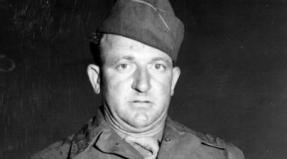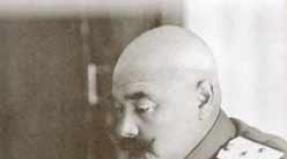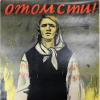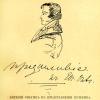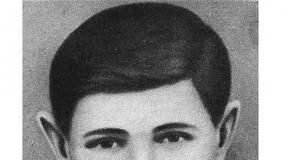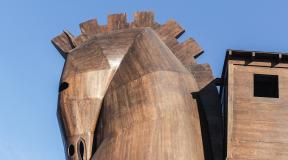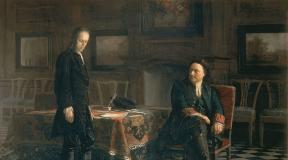Forgotten strike and her lessons. Morozovskaya Stacket
The reasons
The cause of the strike was a sharp deterioration in the situation of workers as a result of the industrial crisis of the early 1980s of the XIX century, as well as brutal exploitation from the owners of the factory. In particular, from to 1884 five times the wages decreased, high fines were introduced, which averaged a quarter of wages and accommodated in some cases up to half of earnings.
The basic requirements of the strikers were increased wages to level -1882, reduction of fines up to 5% of earnings and general relief of the situation of workers. On January 11, Volkov was awarded to the Vladimir Governor "Requirements for the General Agreement of Workers", which contained a clause on the establishment of state control over manufacturers, as well as on the adoption of legislative changes in the terms of hiring.
Suppression strike
In the suppression of the strike, 3 soldiers' battalion and 6 hundred Cossacks under the personal leadership of the Vladimir Governor who arrived in Orekhovo-Zuyevo was participated. Over 600 workers, including Moiseenko and Volkov, were arrested. The strike was finally suppressed on January 17 after a number of clashes between the strikers and government troops.
33 people were given to the court, which, however, were justified by the Jury by the court, due to the difficult situation of workers and violations by the administration of the Manufactory. Participants of the strikes were punished in poor manner: about 800 workers were sent to their homeland under the supervision of the police, P. A. Moiseenko was exiled for 5 years to the Arkhangelsk province, V. S. Volkov - for 3 years in the Vologda province.
Value
As a result of the strike, the workers managed to achieve some concessions: the owners of the factory were reimbursed fines, recovered from October 1, 1884, but the wages were not increased.
The Morozovsky strike caused facilitating the policies of fines in other factories of the Russian Empire, and also led to the development of factory legislation in 1886 (in particular, on June 3, 1886, a law on fines was adopted).
The value of the Morozovskaya strike for the development of the revolutionary movement emphasized V. I. Lenin:
This huge strike made a very strong impression on the government, which saw that workers, when they act together, represent a dangerous force, especially when the mass of jointly operating workers exposes its requirements.
(Full Collection Op., 5 ed., Vol. 2, p. 23)
Wikimedia Foundation. 2010.
- Morozovskaya (Station)
- Morozovsky
Watch what is a "Morozovskaya strike" in other dictionaries:
Morozovskaya Stacket - 1885 (January 17) at the Morozov textile factory in Nikolsky (now Orekhovo Zuyevo). The first mass performance of workers in the Central Industrial Area. Caused by a decrease in salary and large fines. Depressed by armed force, approx. 600 ... ... Big Encyclopedic Dictionary
Morozovskaya Stacket - Morozovskaya strike, 7 17.1.1885, on the textile factory of frosts in s. Nikolskoye (now G. Orekhovo Zuyevo). The first mass performance of workers in the Central Industrial Area. Caused by a decrease in salary and large fines. Depressed by the troops, ... ... Russian history
Morozovskaya strike 1885. - Age of workers textile factory "Partnerships of Nikolskaya Manufactory Savva Morozova, Son and K °" (see Morozov). In a factory located in the town of Nikolskoye Vladimir Province, near the village of Orekhovo (now G. Orekhovo Zuyevo ... ...
Morozovskaya strike 1885. - a strike on the textile F KE partnership of the Nikolskaya Manufactory of Sava Morozova Son and Ka (the town of Nikolskoye Vladimir Lips., Ned Art. Orekhovo (now G. Orekhovo Zuyevo Moscow region)) in Jan. 1885; The first organized mass (approx. 8 thousand ... ...
Morozovskaya strike 1885. - (January 7, January 17), on the Morozov textile factory in Nikolsky (now G. Orekhovo Zuyevo). The first mass performance of workers in the Central Industrial Area. Caused by a decrease in salary and large fines. Depressed by armed force, about ... ... encyclopedic Dictionary
Strike - (from Ital. and Span. Basta! Basta!, pretty!, Enough!) A strike, one of the main forms of the class struggle of the proletariat in capitalist countries, which consists in collective refusal to continue work on the previous conditions. For their goals Z. ... ... Great Soviet Encyclopedia
Union of Soviet Socialist Republics - (USSR, SSR Union, Soviet Union) first in the history of socialist. State It takes an almost sixth part of the dyed land of the globe 22 million 402.2 thousand km2. In terms of population of 243.9 million people. (on Jan. 1971) owls. The union belongs to the 3rd place in ... ... Soviet historical encyclopedia
Morozov - Russian entrepreneurs, owners of textile enterprises. Savva Vasilyevich (1770 1862), from the fortress peasants, got acquainted with the sons in 1820. Found a number of textile factories. Morozov created a number of manufactory comrades, on which in 1915 ... ... encyclopedic Dictionary
THE USSR. Chronology - chronology of historical events of the 9th 1st century BC. e. 9 6 centuries. BC e. State of Urartu. 7 3 centuries. BC e. The domination of Scythians in the Black Sea steppes. 6 5 centuries. BC e. The emergence of the Greek colonies on ... ... Great Soviet Encyclopedia
THE USSR. CAPITALISTIC STROY - Drops of serfdom. Falling of serfdom, decorated by government acts on February 19, 1861 List of shifts in Russia feudally serfdom of capitalist. The main factor that has made the cancellation of serfdom ... ... Great Soviet Encyclopedia
Morozovskaya Stacket
 125 years ago, 7 (19) of January 1885, began the famous Morozovskaya strike. By the time of its completion, even the most ignorant of Russian officials became clear that the scope of labor relations requires state regulation. Otherwise, the collisions between workers and employers will lead to the consequences, from which not only participants in labor conflict will not appear.
125 years ago, 7 (19) of January 1885, began the famous Morozovskaya strike. By the time of its completion, even the most ignorant of Russian officials became clear that the scope of labor relations requires state regulation. Otherwise, the collisions between workers and employers will lead to the consequences, from which not only participants in labor conflict will not appear. Orekhovo-Zuyevo. The building in which the Morozov textile plant was located. Photo of ITAR-TASS
Working Question in Foreign Russia
The abolition of serfdom, as well as the reforms of the 1860s and 1870s, conducted by Alexander II, gave a powerful impetus to the development of the industry, which led to an increase in the number of hired workers. The main supplier of the workforce was the village. However, many peasants, coming to the city for earnings, not only did not enjoy the relationship with the village, but they sought to return home in the midst of agricultural work. This circumstance greatly prevented the development of the class consciousness of hired workers and did not contribute to the emergence of trade unions. A half-eyed-semi-crust was thought about how to collectively defend their rights, silently demolished all the burdens and adversity. And when even the famous Russian long-suffering came an end, they took the calculation and returned to the village.
As a result, the first quarter of the century of Russian capitalism (1861 - 1885) the socio-economic situation of the factory workers remained extremely difficult, and their rights were not protected. Pensions and insurance against accidents and nebraarboles were also not. The government considered overdue to regulate labor relations. Officials in the field are extremely rare (and, as a rule, to no avail) stuck in disputes between labor and capital.
The first performances of workers in the Boreframe Russia were natural and reminded the traditional Russian riot. But after all, the style of the behavior of the then "effective managers" did not differ in the sophistication of the manner.
Almost before everyone began to defend their interests nuts-Zuevian textiles. For the first time, a strike in the factory Savva Morozov occurred in August 1863. And although only 350 people accepted participation in it, the beginning was laid. The strikes in Orekhovo-Zuev occurred in 1872 (twice!) And 1876.
Among other speeches of those years, we note the strike on the Sestroretsky Plant (1867) and the strike of Serpukhov Tapes and Spinners (1869). In the 1870s, only in St. Petersburg on Putilovsky, the unrest took 11 times, and in the Nevsky Mechanical Plant - 7 times. The strikes occurred in St. Petersburg at the Nevsky Pharmacy (1870), near Narva at the Krengolm Manufactory (1872) and in the Smolensk province at the Yartsevskaya Manufactory of Khurudovsky merchants (1880). And although these performances echoed echoed in different parts of the empire, they did not lead to legal consequences. The power was in no hurry to limit the arbitrariness of entrepreneurs. The Morozovskaya strike of 1885 was brought to enlightenment in the brains of officials.
"Effective Management" Timothy Morozova
The founder of the "empire" of Morozov was Savva Vasilyevich Morozov (1770 - 1862). In 1797, being serfs, he founded in the village of Zuyevo on the left bank of Klyazma, a manufactory for the production of silk products. Taking advantage of the royal decree of 1803 on "free blades", in 1820, frosts with four sons were bought out of the fortress capture, paying the landowner with a Rumyn 17 thousand rubles to the assignments. In 1830, he acquired land on the right bank of Klyazma and organized there weaving production.
Morozov's factories were located on the territory of the Bogorodsky district of the Moscow province and the Pokrovsky county of the Vladimir province. The largest - Nikolskaya - belonged to the youngest son of the founder of the dynasty, Timothy. In 1873, he loaned his factories by creating a partnership of Nikolskaya manufactory "Savva Morozova Son and Co." But Timofey Morozov remained the fattest owner: he, his wife and daughter belonged 93% of the shares. Local power was in the hands of the manufacturer. He had influential connections in the provincial center of Vladimir, and in the capitals - Moscow and St. Petersburg.
Not only locals, but also natives of Kaluga, Ryazan, Tambov, Voronezh, Smolensk and Novgorod provinces went to the enterprises of Morozov. The working conditions were such that few of the weavers and spiners lived to 40 years. In the shops stood a rumble, because of cotton dust it was difficult to breathe. Because of this, as well as due to narrow passes between the machines, production injuries became massive. And although the bruises, the fractures of the hands and fingers, the loss of the eyes (due to the departure of the shuttles) often happened, the administration did not hurry with measures. Unfortunately did not manage the side of children and adolescents whose work of Morozov was used widely. Only on Nikolskaya manufactory out of 11 thousand workers and servants about 2 thousand were children. Their work was paid much more modest than the work of adults, which brought a considerable benefit to the employer.
Special hatred workers called the system of fines. "Nikolskaya manufactory with its high fines acquired ... Special fame," Moscow Listok "wrote. - Table of recovery from workers for faulty work and violation of orders at the T-VA factory of Nikolskaya manufactory "Savva Morozova Son and Co." included 735 points on which the workers were fine! The fines were charged not only for lateness and marriage in work, but also for the invitation of guests to the barracks without the permission of the authorities, and for the lack of caps before the hosts. " The working "for the ability without need from cars" could get a fine from 5 to 50 kopecks. The penalty "for washing or drying linen in barracks or kitchen in unspecified time" ranged from 25 kopecks to the ruble. The possibility of choice in the amount of punishment stimulated the arbitrariness of the factory administration. Equally, as well as the presence in the "tabulation" of such vague formulated "limits", as "disobedience to individual orders" (this item administration intercourse with a truly Russian wrestler).
Most workers after shifts went to rest in factory barracks. Family lived in the camorks separated from each other who did not reach the ceiling by partitions, in every camork - two or three families. The bachelors were meant to Nara, on which they slept alternately. "Testament, work in different shifts, and, accordingly, and the routine of each family did not contribute to the creation of conditions for a normal family life and a full-fledged rest. Quarrels between neighbors, as well as husbands and wives were frequent phenomenon here. But the main disadvantage of the barracks were nevertheless not tesnota and a stuff, not life in sight of everyone, as in the city square, not a complete absence of a home coat, but to constantly suppress any manifestation of individuality. Everyone was obliged to live according to a single standard, "the historian N. Polyshchuk believes.
Excessive life "According to the Unified Standard" led to drunkenness, which was deeply rooted among the factory population of Tsarist Russia. "Moscow Listok" assured that in Taurs and Kabakov, Orekhovo-Zuevsky textiles "left half of earnings." Part of the salary workers received "Harces", which Morozov's shops were released at overpriced prices. It also brought more profit faith.
For many years, Morozov has increased momentum. But at the beginning of the 1880s, an industrial crisis broke out, which especially struck in the textile industry. And as usual in such situations, the "optimization of expenses" business has begun with the reduction of wages workers. If in 1882 the men earned 14 - 15 rubles per month - 15 rubles, women - 10 - 11, adolescents - 5 - 6, then the situation has changed. For three years on the Nikolskaya manufactory, rates for produced goods have been reduced five times. But constantly grew the rules of production!
Such a policy allowed the manufacturer even to the crisis 1883 - 1884 to get a big profit - 540 thousand rubles. But frost was unsaturated. On October 1, 1884, he announced the sixth reduction in rates. This is, with the requirement to go to work on a holiday - exhausted folk patience.
32-year-old Peter Moiseenko and 25-year-old Vasily Volkov became leaders of the strike leaders. The indictment in the case of 17 participants of the Morozovka strike gives an idea of \u200b\u200bthe final stage of its preparation: "On January 6, after a dinner in the Trophimov tavern on the sandy shore, a person was gathered between Nikolsky and Soldel, a person gathered fifty workers ... Witnesses of this assessment - employees in the restaurant Vasily Smirnov, Ivan Pogodin and Roman Lemyov showed that Moiseenok (Moiseenko. - ON) and wolves said from among the workers. They read some notes, interpreted that it was difficult to live, that you need to arrange something, consistent about the strike. "
As soon as the participants of the assembly diverged how the director of the factory Mikhail Dianovna became known about their plan (someone Mikhail Larionov turned out to be a baseman). Dianos ordered hundreds of black-workers (peatlands, guard and tatars from the horseman) January 7, from five in the morning, start duty from Novobotsk corps, not allowing clusters there workers ...
STRIKE
The first message about the beginning of the strike was published by 9 (21) January 1885 "Moscow Vedomosti. In the note it was said: "We are reported that in the huge factory Sava Morozov Sons, located in the Pokrovsky district of the Vladimir province, in the town of Nikolsky, at the village of Orekhov, on the border of the Moscow province, there are currently excitement and unrest between workers. The reason for the riots among the workers has a decrease in earnings. "
So, on January 7, in the sixth o'clock in the morning, the black worker, as they were ordered, prevented the accumulation of workers on the street. Weaver were forced to start work. Further, Vladimir Prosecutor P. Communion reflected this: "Exactly at 6 o'clock over the entire body there were screams:" Today is a holiday, finish the work, extinguish the light, women, go out. " Following the wrapping of gas horns, and all the workers of this building with noise and gamas, the "Hurray" cries began to dress and run into the street. The security set here was no longer able to keep the violence of the crowd in several hundred people who sent to the next spinning case. To the appearance of spinners, apparently, were prepared, and when those broke into them, they were also crushed throughout the spinning corps: "Cumming and extinguishing Gas" - soon all the spinners, connecting with weales, went out on the street, attacked here on chernochnik , beat them and hit the river. Then this crowd went around all the factory cases and forced to stop working everywhere. "
Soon all Morozov enterprises stopped. The strike has become universal. Temporarily, the situation came out from under the control of its leaders. The rebeling people gave the will of a long time spent angry. The workers defeated and plundered the factory grocery shop and bakery, broke into the apartment of Master A. Sheorin, who caused universal hatred. In the looting of the shop participated unemployed and workers from other factories, resting on a festive day. The group of workers led by Moiseenko managed to prevent the looting of a cooperative consumer society store (his shareholders were workers and employees). Then Moiseenko gave the telegram to the Minister of Internal Affairs Dmitry Tolstoy with a request to send representatives to clarify the causes of the age.
By 17 o'clock, passions were easy. And late in the evening, the prosecutor of the Moscow Judicial Chamber Nikolai Muravyev (in 1894 he will be Minister of Justice and the prosecutor general) and Vladimir Governor Joseph Sudienko. They were accompanied by the gendarme colonel, the prosecutor of the Vladimir district court and two battalions of the 12th Velikoluksky regiment. A military patrol appeared on the streets.
On January 8, the Governor Sudienko and Prosecutor's employees visited the "fighting". The governor was led to the convoy of 100 workers from the barracks. Among them was and wolves who behaved like a real leader of the workers. Responding to the question of the causes of the strike, he fell especially to the fact that because of the workers' fines "is not able to pay for duties, nor feed their families." Workers demanded to return to them fines, starting with Easter 1884, restore the rates that existed in 1880 - 1881, and dismiss some masters and employees. Other requirements sounded.
On the same day, Timofey Morozov arrived in Nikolskoye. At first, he categorically did not want to make concessions, claiming "that any relief at present would be a concession of gross violence and a bad example that encourages new unrest." But then agreed to reduce the recovery imposed on October 1, 1884, and give the calculation to all workers with the condition of adoption of those who want to work on the conditions announced on October 1.
Such a turn arranged little. The workers threw ads posted in the barrars, and frost threatened to stop the issuance of bread from bakeries, although the January bread was paid. It threatened unpredictable consequences, and Sudienko achieved the abolition of his order from Morozov. Both understood that the strike of the decline does not go, but takes a more organized character.
In the reporting note, the Minister of Internal Affairs Tolstoy Governor Sudienko acknowledged that "with all the elevation of his factory administration, the crowd behaved in relation to" to representatives of power "extremely restrained and respectfully", seeing in them "the only defender from tolerant oppression, and when that brought I was complaining about low prices and excessive fines, I was needed to clarify that there is no law that could force the owner to increase the fee or reduce the fines that this is a matter of mutual agreement with them, which, having flashed at Morozov a discount of fines for the October half, more in I could not do anything to do anything, I was responsible to me with perplexity and reproach: if you can't do anything for us, wherever we contact and who to ask for help and protection. "
This question remained unanswered. The governor did not think about help striker, but about how to break their resistance and force to begin work.
"Requirements for general consent of the workers"
And Sudienko, and frosts have repeatedly appealed for support in the capital. The conflict intervened the Minister of Internal Affairs Tolstoy. He proposed to split the ranks of the strikers: managers to arrest, and natives of other provinces send to their homeland in administrative and police manner - that is, to end with labor conflict by force. On January 9, four hundred Donskoy Cossack regiments arrived in Nikolskoye.
But the workers did not sit back, but prepared a document of historical significance - "Requirements for the general consent of the workers." One part of the requirements was addressed to Morozov: Return of fines from Easter 1884; Restoration of rates of 1880 - 1881; payment of all the days of the strikes arising from the fault of Morozov; dismissal from the factory of masters, oppressed and rudely treated with workers; The cheapening of the products issued from the master store is not more expensive; etc.
Other requirements were addressed to the Government and are aimed at protecting the interests of all workers. Including: to publish the law on which the fines should not exceed 5% of the salary, and deduction for the row - 1 ruble; establish control over the work of the brackets so that the elections from the workers (Council of Starost) checked the correctness of the acceptance of the goods and the imposition of a fine for its damage; Pay simple for the fault of the employer at least 20 kopecks in shift; Tay a law on hiring, according to which the worker would have received the right to go from the enterprise without delays and deductions, warning the administration for 15 days; Protect capitalist to notify the worker about dismissal in 15 days; Salary to issue no later than the 15th day of each month.
Before accepting the requirements, the strikers refused to start work. Morozov rested.
The culmination of the strike reached January 11, when the workers tried to present their demands to the governor. Sudienko sent workers to the prosecutor and ordered the Cossacks ... Arrest Volkov and Fedor Shelukhin. Workers tried to free the comrades. Then the governor ordered to arrest the most active "confusion". 51 people were captured and delivered to one of the barracks. However, the group of workers, headed by Moiseenko, who came followed with the help of stakes and iron rods in the barracks, beat off Karaul 39 arrested and released them through the spare door.
Volkov was not among the liberated. He's late in the evening under Konvay sent to prison. January 12, Nikolskoe was announced in a military situation. By that time, the "garrison" reached 2750 people. Sudienko ordered the expulsion to the homeland of strikers who arrived from other provinces (606 people sent). The factory administration announced the reception of new workers. Morozov agreed to cancel the fines, recovered from October 1, 1884, and dismiss the masters of Shorin.
Over the next days, soldiers and Cossacks drove workers from the barracks. In the cold, they had to decide: to leave the factory or start working. Having hitting the massive blow of the authorities and the entrepreneur who lost the leaders (Moiseenko was hiding, but on January 18, he was arrested), from January 14, the textiles began to return to work. January 20, Alexander III was reported on the restoration of order.
Consequence and courtes
During the investigation, close attention was paid to such criminal offenses, as the defeat of the factory shop and the apartment of Master Shorin, theft of the goods, the violent liberation of the arrested. The investigation materials amounted to 13 volumes. The "organizers" of the strikes betrayed the court.
According to the first lawsuit (February 1886), 17 participants of the strike were held, on the second (May 1886) - another 33, including two women. And although in 1877, several workers were already convicted in the "process of 50" for "walking in the people", including Peter Alekseev (see my article "Self-adjusting against the nationality", "Solidarity" No. 12, 2007), There have not yet seen such a number of stackers on the dock for the defendants.
The court revealed many facts of oppression of textiles. And if in the February process all the defendants received from 10 days to 3 months of prison, then the May process turned to the power of confusion. And the former master Shorine introduced his contribution. He was correct by Morozov, for 22 years, carried out all orders, but in January 1885 he was brought by a victim. Shorine did not remain in debt. He witnessed, he revealed the mechanics of charging fines and their concealment methods: "When the fines achieved 50%, the workers were forced to take the calculation, and then they went to the factory again, they were given new books, and thus might be proof of exorbitant fines - old Calculated books disappeared without a trace. "
As a result, the jury took all the accusations points and justified the workers. Moiseenko recalled: "But the shortwiper was joy: the court returns and announces ... Moiseenko and Volkov, to leave in custody until the decision of the Moscow Judicial Chamber, which was filed by the cassation for the sentence of the Crown Court."
In June 1886, the Moscow Judicial Chamber considered the work of the leaders of Moiseenko and Volkov strikers. Solution: change the measure of restraint to less strict, demand "money guarantee of 100 rubles. With everyone and at the idea of \u200b\u200bsuch a release of them from custody. " In fact, Moiseenko and Volkov were in custody until September 19 and were not released, but were sent to the link with their wives: Moiseenko - in the Arkhangelsk province for a period of five years, and wolves - in the Vologda province for a period of three years. There, eight months, wolves died from tuberculosis. And Moiseenko lived a long life, wrote memories. He died in 1923 in Kharkov, buried in Orekhovo-Zuev.
The historical meaning of the Morozovskaya strike
Under the influence of the Morozovskaya strike, the frightened government published on June 3, 1885, the law "On the reversion of night work minors and women in factories and manufactories." And a year later, the law governed by the relationship of manufacturers and workers and reflecting the demands of nuts-Zuevian textiles. The law limited the amounts of fines. From now on, the penalty money was not in the pocket of the entrepreneur, but for the needs of workers. The law banned paying with jobs through factory shops. Hiring conditions were supposed to be made to the settlement books and were mandatory for workers and employers. At the same time, participation in the strike caught arrested for a period of up to month. Control over the execution of the law has begun to the factory inspection. The new law fell not at the category of "Captains of the Industry". They called him "socialist" and sought a revision.
Evaluating the historical meaning of the Morozovskaya strike, we take into account that after it the power and society began to relate to the work more attentively. Articles on this topic were blocked in newspapers, and not only in the metropolitan. So, Tomsk "Siberian Bulletin" on June 22, 1886 published an article "On the need to introduce factory laws into Siberia." And the famous conservative publicist Mikhail Katkov stated: a Morozovskaya strike showed that "with folk masses is dangerous." Life has repeatedly confirmed the correctness of these words ...
Oleg Nazarov, Doctor of Historical Sciences,
Orekhovo-Zuyevo
DOCUMENTATION
From the testimony of Tver Fedor Kozlov, on the investigation:
"Rate of work is extremely low, and the requirements of steel to the impossibility of strict ... In the same time a piece of the material of the first grade at the rate was for the work of 48 cop., And now - 38 - 40 kopecks. Before a piece of material was 55 Arshin, and now - 65 - 66 and even 67 ... In the same time, 48 - 50 machines were assumed to the submaster, and now 70. The submarine began to help weak less. "
From the speech of the defender Fedor Plevako on the "Process 17" (February 1886):
"Morozova's factory was protected by a Chinese wall from the eyes of everyone, there did not penetrate the beam of light, and only thanks to the strike, we can now trace what was life in the factory. If we read the book about black slaves, outraget, now we are white slaves in front of us ... I touched one here: how much did the worker earned and how much it was calculated in the form of a fine. The numbers say clearly: the average earnings of the working 8 - 9 rubles, deductions on average - from 2.5 to 3 rubles. It was possible to exist on this earnings ... "
When writing an article used: Kabanov P.I., Yerman R.K. Morozovskaya strike of 1885. M., 1963; Moiseenko P.A. Memories (1879 - 1923). M., 1924; Morozovskaya strike of 1885 and the work of the Central-Industrial District of Russia at the end of the XIX - early twentieth century. M., 1984; Morozovskaya strike 1885 - 1935. Collection of articles and memories. M., 1935; Awakening. To the 100th anniversary of the Morozovskaya strike. M., 1984; and etc.
When in 1807, Napoleon forced Russia to abandon the Union with England, the Russian market soon remained without English tissues. Frequently relieved from English competition Textile factories began to grow rapidly. After a Moscow fire in 1812, at which almost all metropolitan factories burned down, even more favorable conditions for the growth of industry were created in the province ...
At Nikolskaya manufactory grew the flow of labor. The peasants were in severe material conditions, and the incoming to work at the factory were accepted in old co-investment. The peasants considered it very advantageous, since for the adoption of the Old Believers, the Old Believers gave a preferential loan for a quick exit from the serf state and to buy a receipt that delivering from a set in the royal army.
By the end of the 80s of the XIX century, on the concentration of production and workers, Orekhovo-Zuyevo occupied third place in Russia after Moscow and St. Petersburg.
At the head of the "Partnership of Nikolskaya Manufactory of Sava Morozova Son and K °" stood Timofey Savvich Morozov - a domineering manufacturer with a huge thirst for profit. Penalties and robes of workers - the main thing, on which he built management in factories.
When hiring, the workers took mortgage money, which were invested in production. The working day lasted 12-14 hours, sometimes textiles worked on holidays. Women's and child labor was widely used. In 1882. men received 14-15 rubles per month, women - 10-11 rubles, teens - 5-6 rubles. Since 1882, Morozov began to slow down the feet of the worker and until 1884 spent 5 grades. Fines in the entire factory were a quarter earnings, and individual workers reached half of the salary. And it was penalted literally for everything: for poor-quality work, for the insection of the church, for smoking, for singing in the barracks, for the absenteeism, for the dignity of the caps before the owner ... The salary was deliberately detained, instead of money, there were special coupons for which the workers were forcibly supplied with products through Harch bench that brought up to 100% profit.
Textiles lived in barracks, 2-3 families in Camork. For idle in large rooms, Nara was built in 2 floors.
Most workers were peasants hired at the factory only in the autumn-winter period.
Unjust hiring conditions, arbitrary administration, fines and salary delays, bad working conditions caused open discontent with workers.
P.A. Moiseenko
Headed the struggle for the rights of textiles Peter Anisimovich Moiseenko (1852-1923). A native of Smolensk province, he came to the Zimin Factory, got a profession there. In 1873 he went to St. Petersburg, where she worked as a weaver in the British Factory of the Shau Brothers. There he met G.V. Plekhanov ( revolutionary, one of the first propagandists of Marxism in Russia), S.N. Halturin, V.P. Obnorsky ( revolutionaries, organizers of the Northern Union of Russian Workers) And accepted an active part in the first economic strike of workers. The real name of the young weaver was Anisimov. For participation in strikes and rallies, he was exiled to Eastern Siberia along with another Luka Ivanov. From the link they returned in 1883. Being at the commencement of the authorities, Anisimov changed the surname to Moiseenko and decided to settle the nut-Zuev's already familiar to him.
In the fall of 1884, Moiseenko entered the Novobytsky factory Timothy Morozov. There he met Vasily Volkov, who adhered to the same revolutionary views as Moiseenko. After some time, Moiseenko organized a mug of like-minded in the factory, which F. Shelukhin, V. Volkov, L. Ivanov, M. Kozlov and others. The task of the mug was the preparation of the agers.
In December 1884, the Weavsky Master Shorin refused to request workers about the salary increase.
And in the morning of January 5, 1885, the office of Timofey Morozova announced on January 7 ("Baptism of the Lord") for a working day, when the workers in Vikulovsky and Zimi factories were going to celebrate the baptism of 2 days ...
It was the last straw. At the initiative of Moiseenko, on January 5, a strike asset has gathered in the restaurant for developing a performance plan.
The beginning of the strikes were chosen on January 7 and swore to stop the factory on this day.
The next day, in the Trophimov Trooper "on the sands" ( Now - the area of \u200b\u200bthe factory respirator. Previously, after the spill, Klyazma left sandnotes in this place, which gave such a name) There were more than 50 people for a detailed discussion of the plan.
According to the plan, the first strikes begin weaves, they will gather at the entrance to the factory, the requirements of the administration will be present. Weales will support spiners and workers of other factories. Strike to spend peacefully without the use of force, without damage to buildings and property. Considering the requirements, break home.
In the evening of the same day, one of the workers stood up the plan of the strikes and the day of her start-up by the Rabbar, and he did about this directory director M. Dianos.
Administration immediately created a group of 400 people to counteract workers. It includes a handyman from the horse's yard, mostly Tatars, worshi, armed with lows, batons, rugs.
By 5 in the morning, the foremanfully stood up at the entrance to the factory and began to drive the approaching tapes into the premises. Then Moiseenko and Volkov agreed with the workers about the beginning of the strikes from the inside.
By hulls rolled: "Gas Light! Come out into the yard! "
Teenagers wrapped the gas crane at the ceiling. Lighting went out. Machines that launched some workers stopped. On the passage, the workers moved to a spinning factory and gas cranes were blocked there.
Everyone went out to the factory courtyard, then on the street and moved to the old weaving factory, from the exit of which the people had already poured. Suddenly there was a cry: "Our beat!" - Protection beat in the courtyard of the factory. The strike books gave fire guards and drove for Klyazma.
Moiseenko led the workers on the mechanical plant and stopped the work there. At the same time, wolves with a group of workers arrived at the collected-bleaching factory and stopped the steam office. Dreamers joined strikers. Then the sawmill and chemical plant were stopped. By 9 am, all Timofey Morozov factories got up.
To present the requirements of Moiseenko, headed for the House of Manager of the Dianov Factories, but he ran out of the house and gave telegrams to Moscow and Vladimir, asking for help.
The workers defeated the houses of Shorin, the director of the Paper Pharmaceutical Factory Lotarev, the Harch shop and bakery, knocked the glass in the office. The following in the queue of the cooperative consumer society store ( Former store number 1 on Lenin Street) I managed to stop. The entire administration of Timofey Morozova was fed.

V.S. Volkov
So, the first part of the strike plan was completed - the factory stood, the strike became universal. Moiseenko and Volkov insisted that the workers went home.
Old weaves were offered to write a petition to the king, ask for protection. Moiseenko knew on his own experience that no illusions about the royal mercies do not have to feed. He discharged by Morozov tapes only half. They agreed not to write the king, but decided to send an urgent dispatch to St. Petersburg to the Minister of Internal Affairs with a request to send a representative to clarify the causes of the strike and the rationale for the requirements of the strikers.
In turn, Timofey Morozov from Moscow gave 2 telegrams to the Minister of Internal Affairs and several - Vladimir Governor Sudienko with a request to take urgent measures. The king Alexandru III became known about the strike.
On the night of January 7-18, Sudienko and two infantry battalions of 12 Velikoluksky regiment in Nikolsky arrived. Equestrian troops arrived from the cover.
On the morning of January 8, Nikolsky was praised by patrols. Sudienko ordered to bring 10 people from each barracks into the courtyard of the office.
Volkov explained to him the reason for workers' unrest. The governor released the detainees and asked to wait for Timofey Morozov's arrival.
Morozov came in the afternoon, advised himself with the governor and the prosecutor, made minor concessions and went to Moscow. The facilities of the manufacturer did not satisfy the workers.
The next day, dyeers, yielding to persuasion director of the beautiful factory, went to work, but the strikers did not give them to work.
On the evening of January 9 in the 8th barracks in Kamork Volkov gathered the leaders of the agers and amounted to "Requirements for the general consent of the workers"which consisted of 2 parts.
The first part written by Volkov, included 7 points and concerned the improvement of working conditions at Timofey Morozov factories.
- The owner must return the work fines, starting with Easter of 1884.
- The partnership has the right for the period from Easter 1884 to the age of leaving themselves in the form of a fine only 5% of the worker's earnings.
- If the owner wishes to calculate any of the workers, then it has to pay salary for the entire period of hiring, until Easter is 1885, i.e. until March 23.
- Restore rates for work that existed in 1880-1881.
- Pay for workers for all days of stackers of 40 kopecks per day, as the strike flashed through the fault of Morozov.
- Do not delay the issuance of halits and bread in the shops during the age of the ages, since the calculation for them was produced by the office forward in December.
- Massay masters and employees whose names will be additionally listed by the workers.
The second part consisted of 14 points and had a all-Russian sound (a kind of workers laws). This part amounted to Moiseenko. The most remarkable historians consider the following items :
- The publication of the state law on fines in the country factories in order to limit the arbitrariness of entrepreneurs.
- According to the law, fines should not exceed 5% from the ruble earned.
- Workers should be warned about poor performance and call into the office to impose a fine no more than 2 times a month.
- The deduction for the forced row of the worker should not exceed 1 ruble.
- Edition of the State Law on Hiring Factory Workers. According to the law, the procedure for hiring and dismissal in factories should be changed. The worker must have a free right of leaving the enterprise at his own request, stating in 15 days about this administration, and leave without any deductions and delays. The manufacturer has the right to dismiss the worker, becoming informed about the calculation for 15 days. You violate this principle manufacturer or worker compensate this two-week earnings.
- The determination of the poor quality of the finished product should be established by presenting the goods and with witnesses from workers. The results of the inspection are recorded in a commodity book ...
- To introduce state control over the salary of the worker.
- Issue salary to produce no later than the 15th day of each month or first Saturday after 15.
- The simple workers in the fault of the capitalist should be paid for at least 40 kopecks per day or 20 kopecks in shift.
- Free choice of Starost in the working artel.
Thus, in "Requirements", Nikolsky workers dictated the main provisions of the factory legislation, expressed the interests of the industrial proletariat of all Russia.
On January 10, the owner in Orekhovo-Zuyevo did not come, and the workers did not wait for an answer to their requirements. In the evening, the train with 4 hundred Cossacks of the 1st Don Cossack regiment arrived from Moscow.
On January 11, the king, having received a reporting note of the Minister of the Interior D. Tolstoy, refused to give any concessions and relief, and Tolstoy gave an order to the graciousness of the riskers.
When a thousand crowd was gathered at 10 o'clock in the morning, and the wolves tried to read his demands to Sudienko, the governor ordered the arrest of instigators. Unarmed workers fighting only and waiting for the order of soldiers with bayonets. Forces were clearly unequal. Negotiations ended with beating workers and arrest of about 50 people (with wolves and husk).
The second group of workers led by Moiseenko learned about the arrest of Volkova. With the help of workers from the nearest barracks managed to break through the barrier of the Cossacks and soldiers to the factory courtyard and release most of the arrested.
Moiseenko was easily wounded. Attempting Sudienko to arrest the leader of the strikes failed, the workers hid it in the thick of the crowd.
Volkov and Shelukhin could not be released. In the evening of the same day, the train took the arrested in Vladimir prison.
Sudienko requested another 2 hundred Cossacks and the infantry battalion. The street fighting of workers of the Walnut-Zueva with the troops on January 11, 1885 became unprecedented accomplishment on the scale of the act of struggle of the proletariat of Russia for their rights.
January 12 was marked by the beginning of the mass arrests of the strikers and send them without property and documents at the place of residence. The remaining workers were invited to go to work.
In total, 6 hundred Cossacks and 5 infantry battalions were concentrated in Orekhov. Nikolskoye was announced in a military situation, Transitions to Zuyevo, Dubrovka were closed.
January 14 - arrests and expulsion continued. The workers were drunk at the factory. I managed to make 600 people work. Moiseenko secretly reached Moscow.
January 17 - Badges retreated. Moiseenko returned from Moscow. In Brother's apartment in Likino, he was arrested and the next day was taken to Orekhovo.
Sudienko sent another telegram to Tolstoy: "People willingly go under arrest, not bringing extension of special results ..."
The minister told the government that 4508 people operate in Nikolsky factories, although in fact they would give them half of the named figures.
January 21 - Timofey Morozov arrived in Orekhovo. He fired a bunch of people, and for hiring new workers sent to the agents in the villages.
January 24 - a little more than half of all workers began to work (4328 out of 8000!)
The loss from the factory stop amounted to 35 thousand rubles. By the end of January, about 800 people were sent from Nikolsky.
In fact, the strike lasted 17 days - from January 7 to 23. Timofey Morozov agreed to cancel the fines, dismiss the masters and employees, especially hated workers, gave the calculation by those who did not want to work on the previous conditions.
By the court in Vladimir, 43 people were attracted. The first process took place on January 7-8, 1886.
Moiseenko, wolves, Ivanov and others were in conclusion more than a year. A lawyer who carried out their protection was able to prove the malicious violation of laws and the arbitrariness of the Timofey Morozov administration. Nevertheless, the leaders of the agers received for 3 months of arrest, the rest were given even less.
The second process involving jury took place over 33 strikers, who were accused of attacking the guard, pogroms and street riots. The process began on May 23, 1886. On it, the master Shorine admitted that he was fined for a good job - so he demanded the owner that the salary was falling for two years 5 times ... Morozov was evident.
The jury was justified by the defendants. Everyone was released.
(Moiseenko and wolves 2 months stayed in prison, then went to the link. Moiseenko - in the Arkhangelsk province for 5 years, wolves - in Vologda for 3 years, where he died of tuberculosis in 1887 ... Moiseenko later participated in the October Revolution, then in the Civil War. Shortly before death, Moiseenko visited Orekhovo-Zuev again, attended the opening of the Monument V.A. Baryshnikov (Bolshevik, Commissioner of Reviable). Moiseenko died in Kharkov in November 1923 and was buried in Orekhovo-Zuev at the foot of the monument to the wrestlers of the revolution on the courtyard of 1185 strikes.)
For the first time, the Morozovsky strike was named G.V. Plekhanov. It was the first planned and organized political performance of workers against the autocracy, which was attended by several thousand people, and for the first time in Russia, the demands of the strikers went beyond the individual enterprises, expressing the interests of the entire working proletariat.
Stolyarov Stanislav Petrovich
Full Member of the Morozov Club
Honored Teacher of the Russian Federation, Professor
Morozovskaya strike in 1885:
Causes of its consequences
Among the Morozov factories, Nikolskaya Manufactory "Savva Morozova Son and K" was the first magnitude. He managed it the younger son Timofey. He acquired his professional skills, working from 12 years at the Father factory, and at the age of 16 became one of the chief leaders of the family case of Morozovy. Chairman of the Moscow Exchange Committee of N.A. Gave him such a characteristic:
"He was a man who had common sense, but, as he had not received any education, needed a constant manual. One of his main drawbacks was stubbornness and self-conceit. He did not understand what could be a good manufacturer, but the extremely bad leader of any, although not particularly demanding society. "
Stubbornness Timofey Savvich under the end of his life played a bad joke with him when his own workers rebelled against him.
Among the factory settlements, Nikolskoe was distinguished by peculiar orders and managerial structures. Here the owner was Timofey Savvich, who focused all the completeness and civil authorities. He said: "With the money, I want, I will do." And he did according to his own arbitrariness not only in himself in the county and province, but even in Moscow and St. Petersburg, where there was influential connections in the highest official spheres.
In the town of Nikolskoy, two firms were working independently: one belonged to Timothy Savvich called the Savva Morozov Son and K, and the other - Vicule Eliseevich - called the trade partnership of Manufactory "Vikula Morozov with sons".
An affiliation of frost to old-procurement, loyalty to the religious and moral polls of the ancestors led to their constant care for improving the living conditions and life of workers. In Orekhov, 58 barracks were built.
It was in the life of Timofeya Savvich by the owner of Nikolskaya Manufactory, a small factory town was created with him, which posted the beginning of the future city of Orekhovo-Zuyevo. It consisted of about 450 residential, economic and social buildings. So, Timofey Savvich was not grated in relation to the workers. At least, not burned to the arrangement of their life.
Nevertheless, in the village of Nikolsky on January 7, 1885, a Morozovskaya strike began, which lasted 11 days.
On the very first day, the strike in it took a huge number of workers at that time - more than 6 thousand people. What caused such a massive protest? On this question, different sources respond unequivocally: the causes of the strikes began to reduce wages and high fines in production. It should be recalled that in the Nikolsky factory there were several more strikes in 1863, 1872 and 1876. But then the workers did not oppose the entire operation system, but only individual owners. They still had strong faith in the intercession of the highest superiors and the king himself. The Morozovskaya strike of 1885 was one of the largest milestones in the formation of the revolutionary consciousness of the workers - the transition from the elemental struggle with the "oppressants" to the struggle organized, under the leadership of advanced workers. From 1882 to 1884, Timofey Morozov slowed down a salary five times. At the same time, the fines became stricter and stricter: in all the factory they constituted almost a quarter earnings, and sometimes separate workers reached half of earnings. In those days, he was fined in Russia at all enterprises, but especially severe at Timofey Morozov factories. The recovery tab of the workers included 735 points. The burden of the position of the workers was aggravated by political cure. All this outraged the workers and called a decisive protest. In the report of the Vladimir Governor I.M. Sudienko Minister of Internal Affairs Count Tolstoy about the progress and causes of the strikes in the factories in Nikolsky said: "I ... I could not help but be convinced that the reason for the regrettable events that began on January 7, was the extreme oppression to which workers in the factory." The organizer and leader of the strike became working Peter Anisimovich Moiseenko. So, on January 7, 1885, the workers refused to proceed with their duties. The first day was marked by mass riots and pogroms. P.A. Moiseenko, seeing pogroms, resolutely demanded to stop them. The Minister of Internal Affairs Graph Tolstoy recommended the governor to break the resistance of the strikers by force.
On January 8, the governor with the infantry regiment and five hundred Don Cossacks arrived at the factory. The same strike was able to suppress the power only on only January 17. The strike ended, but its consequences were stronger than it could be assumed. And the point is not that Nikolskaya manufactory suffered colossal material losses of several tens of thousand rubles. But the most difficult consequences of Morozovskaya strikes for Timofey Savvich is as well as for his son Savva, at the time of the Moscow University student, the moral damage was. "After a strike, decent people ceased to heart up with me - recalled Savva Timofeevich, and in the people and to this day there are groan songs about Savva Morozov, and they think that this is about me. Go, argue that I am not Timofey Savvich! "
After the completion of the Morozovskaya strikes above its active participants, two trials took place in the Vladimir District Court. The first passed in February, and the second is in May. The February deliberation was appealed as he carried out without jury. The second was already held in the presence of jury meetings. Unlike the first, he received a broad publication. In many ways, because the case turned out not in favor of Timofey Savich. The court of jury were transferred to the "workers among the 33 people, held in custody" and 72 people who were at freedom, under the supervision of the police. These included headache strikers - P.A. Moiseenko and V. S. Volkov.
The workers defended the largest judicial speaker of that time "Moscow Zlatoust" F.N. Pleumo. In the process of trial, Timofey Savvich unexpectedly discovered that roles in the judicial theater were changed. Now the workers have become a party to the accusation, and he turned out to be accused. The jury, on the decision of which the court staged 101 the question of the guilt of the defendants, answered all the questions negatively. Thus, the accused was made an acquittal sentence. As a result, only us suffered punishment out of 105 accused of unrest. The only culprit of the strikes ultimately turned out to be Timofey Savvich Morozov.
Frightened by folk unrest, the owners of the factory went on some concessions. However, the governor ordered to excrete strikers in the village, to his homeland. A total of 603 people were sent. Peter Moiseenko will hold a single year in prisons and references, will lose his companion V. Volkov, who died in the link from Chakhotka, will again and again serve the case of the revolution, and at the end of life will return to his native-zuyevo, where it will be buried on the square " The courtyard of the strikes. "
The owner of Nikolskaya Manufactory after the trial went to the Crimea to correct his health. However, on October 10, 1889, at the age of 66, he died on his Crimean cottage in Mishore.
The period of sole dictatorial management of Nikolskaya manufactory ended. There was a new period of the collegial, managerial leadership. At the same time, a new stage began in the development of Nikolskaya manufactory and in the life of Savva Timofeevich Morozov, who was marked by success for him in all the main directions of its activities.
The most prominent person in Russia's wide-famous family of Morozov, undoubtedly, was Savva Timofeevich Morozov (1862-1905). In his life and activities, the best thing was shown to be accumulated by the Morozovsky Dynasty for more than a hundred years of entrepreneurial, public and charitable activities of the numerous family. Characterizing S.T. Morozova, his contemporaries in one voice said, it was a man of a big mind. A person is surprisingly thin, thinking, according to the artist Prince S.A. Scherbatova, the "smartest of merchants." Only the listing of titles S.T. Morozova characterizes its multifaceted and active activity at the turn of the two centuries of the history of Russia. Already at the age of 24, he could successfully manage such an industrial Machina as Nikolskaya manufactory, where more than 30 thousand workers and employees work. In the center of all social activities, Savva Timofeevich got a "work issue". All of his aspirations in solving the urgent issues of Russian life were aimed at conducting political reforms. At the legislative level, he defended the rights of workers: the right to fair working conditions, to reduce the working day, and later in the 1900s - the creation of unions, the right to strike, etc. Even at the beginning of the 1900s, Savva Timofeevich showed liberal views, taking advantage of the system of representative rule, limiting, but not canceling autocracy, for universal direct elections, for ensuring civil rights and freedoms. The most important transformations were carried out in updating the material base of production. In 1885-1899, new factories were built, equipped with the latest technology. These were bright and spacious housings, which were easily breathing and worked. On the shoulders of Savva Morozov lay a decision of another major question - social.
The relationship between workers and entrepreneurs began to rebuild. Not least this happened due to the Morozovsky strike and its consequences. Laws on the abolition of night work of women and children under 12 years old were adopted. And a much more substantial law on fines.
In terms of industrial development in the last decade, the 19th century, Russia overtook all European countries and went to the US. During the Board, S.T. Morozova Nikolskaya manufactory City Orekhovo-Zuevo became the third center after Moscow and St. Petersburg on the concentration of industrial potential.
Power and society
To the 120th anniversary of the "Morozovskaya strike" of 1885
On January 19, 2005, 120 years old by the famous Morozovskaya strike, which occurred in the January days of 1885 at Nikolskaya Manufactory in Orekhovo-Zuev, who belonged to the partnership "Savva Morozov, Son and Co.". The date of the celebration, by the way, was established by the decision of the Presidium of the Orekhovo-Zuyevsky district Council of Workers, Peasant and Krasnoarmeysian deputies on January 13, 1923.
Morozovskaya Stachka prompted serious shifts in government policy on the work. The effect of strikes on the economic and social position of the working class has been studied in different periods of Russian history. True, under different "angles of view", from different positions. But, nevertheless, attention to the strike does not weaken now.
Let's try to get into historical documents and numerous works of historians, noting that the work issue remains in Russia, as well as around the world, relevant. We will do the same as amendment - the relevance of this issue in Russia is incomparably higher than anywhere, due to the special conditions of capitalization.
The life situation of the last quarter of the nineteenth century for Russia was extremely severe. The ruinous Russian-Turkish war of 1877-1879, chronic and large-scale faults undermined the economy of the country, aggravated social contradictions, led to the impoverishment of wide segments of the population and, in particular, the peasantry. The cotton industry in these conditions suffered many times - its workers have not yet been "broken away" from the ground and remained largely dependent on the state of their peasant affairs in the village, and the main consumer of the Sitchik - again, the peasantry - lacked on breadcrumbs . The newspapers of that time were noted: "stagnation in trade throughout Russia accepted unprecedented sizes." Rural Russia shook his hunger, and industrial Russia shook unemployment and the same hunger. The Moscow provincial Zemstvo noted: "In some localities, production almost suspended, the entire factory people lived at home without earnings." Not far to trouble.
Factories, crowded factory villages in Central Russia, many, and Morozovskaya Stachka happened precisely on the Nikolskaya manufactory and became a state-owned event. Note that not in Glukhov or Zuev. And there, and here the owners were representatives of the old goods of Morozov. It is characteristic that it was Morozov, without listening to Russian "thunderstorm risks", for a long time defended their own ideas about the relationship between the owner and worker, which were based on patriarchal, authoritarian foundations characteristic of the life of old-belt communities. Several paraphrasing P. Ryabushinsky, let's say: "Praying for the forgiveness of sins, the old-order industrialist spoke before the icon that" many people gave the opportunity to earn money, feed the family, grow children and it will start him by the Lord, "and immediately remember the continuation: "But the time will come, and a young voice from the crowd of workers will cry:" We are thousands and we work for you - Darmond. " Oh, the same, these words, unfair - not from the sky, fell by the same Morozov, their property and did not give it to them, she studied their own works and then. But the crowd has its own "logic".
Workers of Nicolskaya manufactory knewed before 1885. In 1865, the first real working age in Russia occurred here. The workers then asked the owner, though a little relief their position: "Reduced the working day, to increase wages and make other concessions that are not worthwhile for the owner." But not a single step to meet the requests of the workers was not done, the instigators with families were thrown into the street. That's all ended.
The events of 1885 were brewed for a long time. Against the background of a common heavy position, which was already mentioned above, the then nominal owner of Manufactory Timofey Savich Morozov (1823 - 1889) continued his long-term struggle for improving labor productivity and, most importantly, product quality. It would be naive to believe that a former peasant, which suddenly became a worker at the enterprise, who had never seen the technician ever-visited, turned overnight in a qualified and disciplined employee. The head of the Morozovskaya strike Peter Anisimovich Moiseenko (1852 - 1923) in his memoirs frankly says: "It was difficult to get used to the factory atmosphere after driving Siberia." It only tells us that the essence of the contradictions of intrababic life on manufactory is far from unambiguous.
Specified on the manufactory "Tabel recovery from workers for faulty work and violation of orders in the factory ..." Specified 735 points. We emphasize another feature of the "kingdom" Timofey Savvich - he built large and warm barracks for workers, hospitals, schools, more than a million rubles made to a loan-savings office. A huge concern for their employees at the time. At the same time, he could rather cynically say: "Pokrov, a county city - he is my notch, Vladimir - my pocket. All my, all mine: With the money I want, then I do. "
Let's turn again to the memoirs of Peter Anisimovich: "... Morozov stranked the fines: there are no urenens, there was nowhere to go with the family ... I approached the Christmas holidays, waited for the payments: everyone expected that he would get, and that he could buy ... the pay came, and there was nothing to get ... Harci (issued in the master shop on the book, in debt; Prices in the shop, as a rule, were higher than market - ed.), Because fines. Earnings 8 - 9 - 12 rubles. No more, deduction of fine 3 - rubles., And even more, here and live, as you know ... There was no little tears from poor weaves, which did not have enough earnings on Harci, and they remained indebted by the office. Men earned 12 - 15 - 17 rubles, fines on average accounted for at least 3 r. 50 cop., Yes Harci and had to receive 2 - 3 rubles. " "Revolutionary" experience tells Peter Moiseenko to the tactics of immediate actions: "It was here that it was necessary to pour oil into the fire." Found for Peter Anisimovich and Assistant - Vasily Sergeevich Volkov (1860-1887), which he characterizes in memories as a friend "intelligent and sensible". In addition, he "was young and beautiful, that he won a lot among weaves."
Not in vain among the workers, Moiseenko received a nickname "Student", let's read in his memories - as he was so agitated that thousands of workers followed him: "Today, Savva Morozov, and tomorrow Elisa Morozova (Factory Elisha Savvich was located in D . Zueva - Ed.), And therefore, we, workers, must support each other and unite into one common union; When we unite and support each other, then we will be strong and will be considered with us, it is said: "In the union of power." Until now, we were not considered with us because they saw the fragmented mass in us, and they did what they wanted and how they wanted, that's why the strike was strengthened into such forms ... it is necessary to learn not only at school, but also outside it, read useful books, and Not the "Bow of the Kingdom" and "Eruzlan Lazarevich", "Bridegroom in Innilah, yes the Bride in the Sch), and take from the library of Nekrasov, Pushkin, Belinsky, Dobrolyubov, Pisareva, etc.". Yes, Peter Anisimovich did not live to our time, to the "Russian Radio" and other things. How not to remember the words of the writer Valentina Rasputin: "If Pushkin had listened to the tales of Arina, and the songs of Alla Pugacheva, he would not become Pushkin, and Dantes."
But back to the memories of Moiseenko: "... At all, the strike was reflected. Zuyevsky manufacturers frightened before they hurried to post the announcement everywhere that the fine would say goodbye to the earnings increase by 10% for all work ... You see how we have helped the workers, even those that never thought to be added to them. "
Nikolskaya Manufactory has not worked for several days; Thousands of people went to the streets. It did not cost without a discrepancy, but this in most part should be attributed to the expert on the crowds to join the crowds of the Orekhov Bosya's workers, which in the "peaceful" time was horrified by the population. Moiseenko writes: "We stood a huge mass, we were thousands." By this time, the demands of the workers have already been discussed and set forth "on paper": "1) We, all workers, we demand the destruction of all fines and return the fines taken from October 1, for three months; 2) increase wages to everyone, without exception, by 25% for all works and varieties; 3) paying for all the trace days, during the opening of the work, which occurred due to the fault of the owner, because we were burdened with exorbitant fines and low rates; 4) installation of brave controls from elected from workers who could check the correctness of the acceptance of goods and imposing a fine for the actual and indispensable damage, as it was before; 5) dismissing masters from the factory for their oppression of workers and the coarse relationship with workers ...; 6) the cheapening of products issued from the master store is not more expensive than the market ... ". In total, in the list of requirements of 17 paragraphs. This document was transferred to the Vladimir Governor, was sent by Peter Moiseenko Telegrams with information on requirements and to the Minister of Internal Affairs. If you quit a retrospective view on the history of the "work movement" in the Bogorodsky district, it should be noted that long before the "Morozovskaya strike", at the end of the 18th - early 19th centuries, with similar requirements, the peasants of the Pryanovskaya and Kupavinian factories appeared. As for the appeals to the supreme power, the elected from these peasants were not much shy and reached "hiking" to the greatest Catherine. It will not be superfluous to say: the workers of other factories - and the near and distant - the lessons of the "Morozovskaya strike" were interested in and the requirements of the "Morozovsky" were the backbone of such documents up to 17 years. As for paying for strike days, this example has become an infectious - the October Revolution and the subsequent civil war were almost fully paid by Russian industrialists and merchants. By the orders of the Rev QUCOM and Soviets, they were charged in "an urgent duty" to pay full for non-working "revolutionary days", during rallies and manifestations, pay "ink and paper" for these bodies, as well as to give the allowance to the Red Army, who went to the fronts of the Civil War, for " A few months ahead. " Very even tables for the first indicative "Komsomolsk" weddings, innovatives were obliged to cover at their own expense.
What results were achieved by the workers of Nicolskaya manufactory? The authorities made a fairly detailed investigation, which once again confirmed that "the reasons that caused these riots did not have a random nature, but were caused by incorrect relations between manufacturers and workers."
A court took place at the "instigators" of the strikes, at which the famous F. N. Plevako spoke by the defender, which in his speeches was compared factory with "white slaves." P. A. Moiseenko and V. S. Volkov, after several meetings in different courts, were sent to the administrative link: the first to Arkhangelsk, and the second - to the Vologda province. Timofey Savvich Morozov left the leadership of the manufactory and handed them to his son - Savwe Timofeevich, the industrial and man of the new formation, a graduate of Moscow University. It was easier to live a worker, but strikes became an ordinary. At the same time, Russia received new working legislation - the Law on June 3, 1886, which regulated the rules for "hiring workers at factories, factories and manufactories" and "Special rules on mutual relations of manufacturers and workers." This law has been implemented with the well-known Russian accuracy and terminality, which, to some extent, contributed to the future fate of Russia.
When preparing the note, literature was used:
Memories of P. A. Moiseenko. 1873 - 1923. M. 1924. P. 55 - 113.
Extract from the Resolution of the Presidium of the Orekhovo-Zuevsky West Communication dated January 13, 1923 "On the celebration of the 38-year-old anniversary of the" Orekhovo-Zuyevsky Workers "strikes (CGAM F. 66, OP. 11, d. 980, LL. 26).
Kantor R. Morozovskaya Age of 1885 // Archive of labor history in Russia. Second book. GH. 1921. P. 44 - 53.
Konovalov A. Orekhovsky Cotton Combine // Annual Rings of History. The history of factories and factories of the city of Orekhovo-Zuyevo and the Orekhovo-Zuevsky district. OR. -Zuevo. 1999. P. 15 - 44.
Laverdychev V. Ya., Solovyova A. M. Combat Poche in the Russian proletariat. M. 1985.
Kupriyanova L. V. "Working Question" in Russia in the second half of the XIX - early twentieth centuries // History of entrepreneurship in Russia. Second book. The second half of the XIX is the beginning of the twentieth century. M. 2000. P. 343 - 437.
Shahanov N. The first strike of workers in Orekhovo-Zuev // Katorga and reference. Historical and revolutionary messenger. Book fifty ninth. M. 1929. P. 43 - 52.

